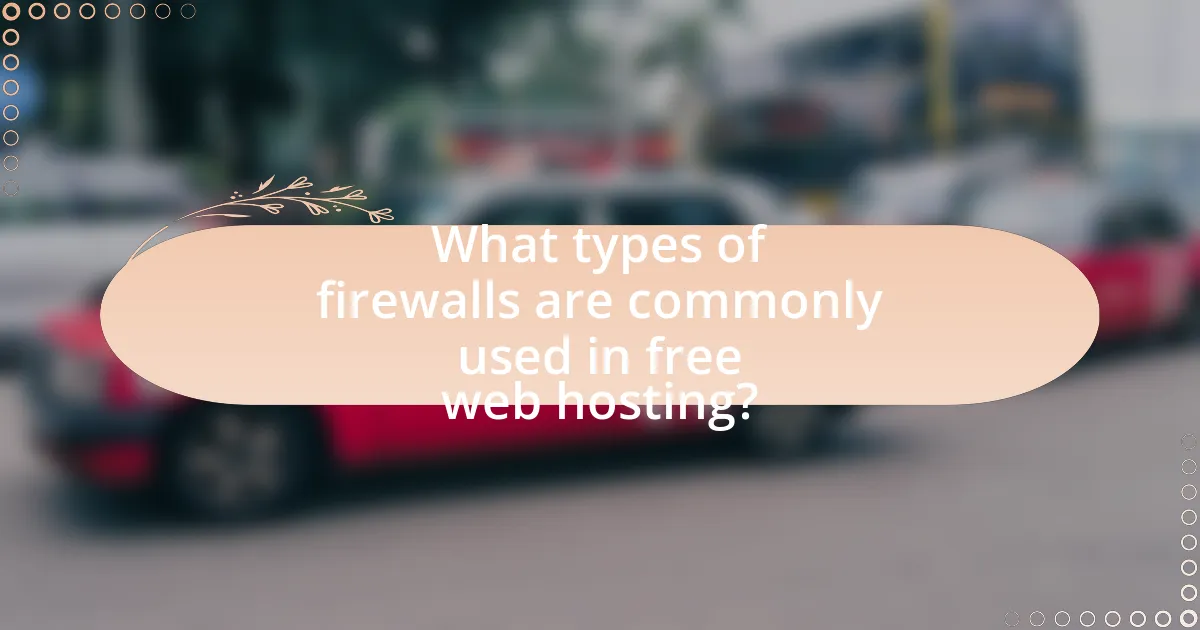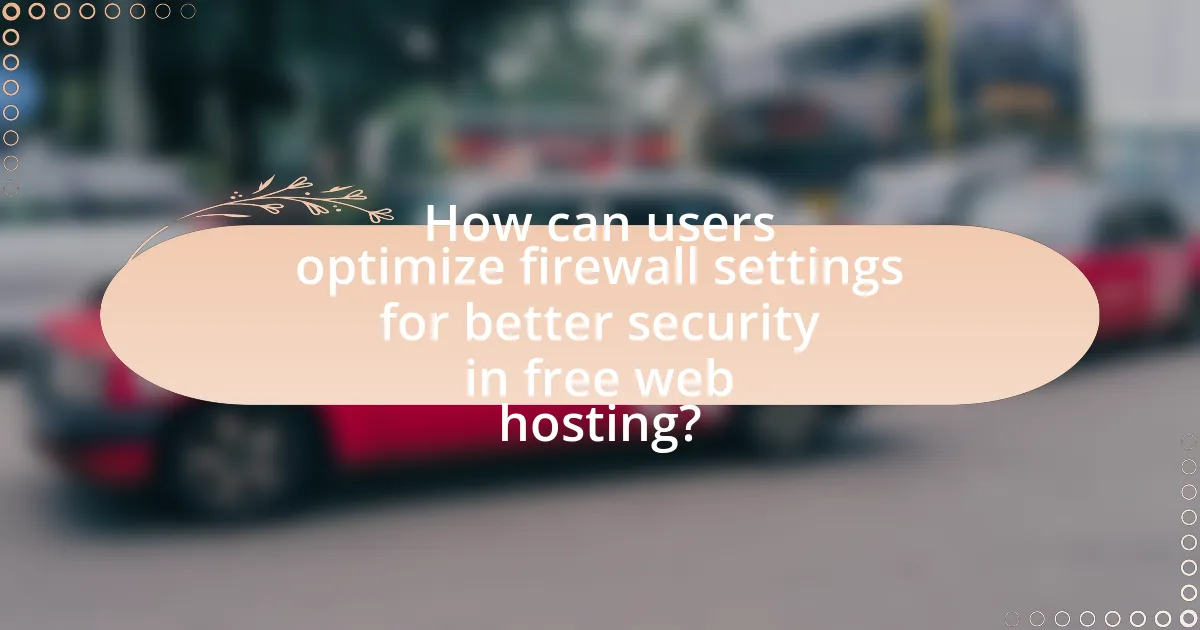Firewalls are essential components in securing free web hosting environments by monitoring and controlling network traffic based on established security rules. They serve as barriers against unauthorized access and cyber threats, such as DDoS attacks and malware, thereby enhancing the overall security posture of hosted websites. The article explores the functionality of firewalls, their key components, and the specific threats they protect against, while also discussing the differences between hardware and software firewalls. Additionally, it highlights best practices for configuring firewalls, optimizing settings, and troubleshooting common issues to ensure robust security in free web hosting scenarios.

What is the Role of Firewalls in Free Web Hosting Security?
Firewalls play a critical role in securing free web hosting by monitoring and controlling incoming and outgoing network traffic based on predetermined security rules. They act as a barrier between trusted internal networks and untrusted external networks, preventing unauthorized access and potential attacks. For instance, firewalls can block malicious traffic, such as Distributed Denial of Service (DDoS) attacks, which are common threats to web hosting services. According to a report by the Cybersecurity & Infrastructure Security Agency, implementing firewalls can significantly reduce the risk of data breaches and cyberattacks, thereby enhancing the overall security posture of free web hosting environments.
How do firewalls function within free web hosting environments?
Firewalls in free web hosting environments function as security barriers that monitor and control incoming and outgoing network traffic based on predetermined security rules. They protect hosted websites from unauthorized access, malware, and various cyber threats by filtering traffic and blocking potentially harmful connections. For instance, a firewall can prevent DDoS attacks by identifying and mitigating excessive traffic directed at a server. Additionally, many free web hosting services implement firewalls to safeguard shared resources, ensuring that one compromised site does not jeopardize others on the same server. This layered security approach is crucial, as free web hosting often lacks the robust security measures found in paid services, making firewalls essential for maintaining the integrity and safety of hosted websites.
What are the key components of a firewall in this context?
The key components of a firewall in the context of free web hosting security include packet filtering, stateful inspection, proxy services, and intrusion detection systems. Packet filtering allows the firewall to examine data packets and determine whether to allow or block them based on predefined rules. Stateful inspection enhances security by tracking the state of active connections and making decisions based on the context of the traffic. Proxy services act as intermediaries between users and the web, providing an additional layer of security by masking the user’s IP address and filtering content. Intrusion detection systems monitor network traffic for suspicious activity and potential threats, enabling timely responses to security breaches. These components collectively enhance the security posture of free web hosting environments by controlling access and monitoring for malicious activities.
How do these components interact to provide security?
Firewalls interact with other security components, such as intrusion detection systems (IDS) and antivirus software, to provide comprehensive security in free web hosting environments. Firewalls monitor and control incoming and outgoing network traffic based on predetermined security rules, effectively blocking unauthorized access while allowing legitimate traffic. Intrusion detection systems complement firewalls by identifying and alerting administrators to suspicious activities that may bypass firewall protections. Antivirus software scans for and removes malicious software that could exploit vulnerabilities in web applications or servers. Together, these components create a multi-layered security approach, reducing the risk of data breaches and ensuring the integrity of hosted websites. This interaction is essential, as studies show that layered security strategies significantly enhance overall protection against cyber threats.
Why are firewalls essential for free web hosting security?
Firewalls are essential for free web hosting security because they act as a barrier between trusted internal networks and untrusted external networks, preventing unauthorized access and attacks. In the context of free web hosting, where resources are often limited and security measures may be less robust, firewalls help mitigate risks such as data breaches, malware infections, and denial-of-service attacks. According to a report by the Cybersecurity & Infrastructure Security Agency, firewalls can block up to 90% of common cyber threats, making them a critical component in safeguarding web hosting environments that may lack comprehensive security protocols.
What specific threats do firewalls protect against?
Firewalls protect against specific threats such as unauthorized access, malware, and denial-of-service (DoS) attacks. Unauthorized access occurs when malicious actors attempt to infiltrate a network, which firewalls prevent by filtering incoming and outgoing traffic based on predetermined security rules. Malware, including viruses and ransomware, is blocked by firewalls that identify and restrict harmful data packets. Additionally, firewalls mitigate denial-of-service attacks by monitoring traffic patterns and limiting excessive requests that could overwhelm a server. These protective measures are essential for maintaining the security and integrity of web hosting environments.
How do firewalls enhance the overall security posture of free web hosting?
Firewalls enhance the overall security posture of free web hosting by acting as a barrier between trusted internal networks and untrusted external networks, thereby preventing unauthorized access and attacks. They monitor incoming and outgoing traffic based on predetermined security rules, which helps to block malicious activities such as hacking attempts, malware distribution, and denial-of-service attacks. For instance, a study by the National Institute of Standards and Technology (NIST) highlights that firewalls can reduce the risk of data breaches by filtering out harmful traffic, thus protecting sensitive information hosted on free web servers.

What types of firewalls are commonly used in free web hosting?
Commonly used firewalls in free web hosting include network firewalls, application firewalls, and web application firewalls (WAFs). Network firewalls monitor and control incoming and outgoing network traffic based on predetermined security rules, while application firewalls filter traffic to and from web applications, providing an additional layer of security. Web application firewalls specifically protect web applications by filtering and monitoring HTTP traffic, which is crucial for defending against common threats like SQL injection and cross-site scripting. These types of firewalls are essential in free web hosting environments to mitigate risks associated with limited resources and shared server environments.
What are the differences between hardware and software firewalls?
Hardware firewalls are physical devices that protect networks by filtering traffic at the network perimeter, while software firewalls are applications installed on individual devices to monitor and control incoming and outgoing traffic. Hardware firewalls typically provide a centralized point of security for multiple devices within a network, offering robust protection against external threats, while software firewalls offer customizable security settings for individual devices, allowing users to manage their own security preferences. According to a study by the SANS Institute, hardware firewalls are often more effective in handling large volumes of traffic and can provide better performance for enterprise environments, whereas software firewalls are more flexible and easier to update for personal use.
How does each type impact free web hosting security?
Firewalls significantly impact free web hosting security by acting as a barrier between trusted internal networks and untrusted external networks. Different types of firewalls, such as packet-filtering firewalls, stateful inspection firewalls, and application-layer firewalls, each provide varying levels of security. Packet-filtering firewalls analyze data packets and allow or block them based on predefined rules, which can prevent unauthorized access but may not inspect the content of the packets. Stateful inspection firewalls maintain a record of active connections and make decisions based on the state of the connection, offering enhanced security by tracking the state of network traffic. Application-layer firewalls, on the other hand, inspect the data at the application level, providing the highest level of security by filtering traffic based on specific applications and protocols. The effectiveness of these firewalls in free web hosting environments is crucial, as they help mitigate risks such as DDoS attacks, unauthorized access, and data breaches, which are prevalent in free hosting services due to their lower security measures.
What are the advantages and disadvantages of each type?
Firewalls in free web hosting security can be categorized into two main types: hardware firewalls and software firewalls. Hardware firewalls provide a physical barrier between the network and external threats, offering advantages such as high performance and the ability to protect multiple devices simultaneously. However, they can be expensive and require physical installation and maintenance.
On the other hand, software firewalls are installed on individual devices, offering advantages like cost-effectiveness and ease of installation. They can be tailored to specific applications and user needs. However, software firewalls may consume system resources and can be less effective against network-wide attacks.
In summary, hardware firewalls excel in performance and multi-device protection but come with higher costs and maintenance needs, while software firewalls are more affordable and customizable but may have limitations in resource usage and overall network protection.
What role do firewalls play in managing traffic for free web hosting?
Firewalls play a critical role in managing traffic for free web hosting by monitoring and controlling incoming and outgoing network traffic based on predetermined security rules. They act as a barrier between trusted internal networks and untrusted external networks, ensuring that only legitimate traffic is allowed while blocking potentially harmful requests. For instance, firewalls can prevent Distributed Denial of Service (DDoS) attacks, which are common threats to free web hosting services, by filtering out excessive traffic that could overwhelm the server. Additionally, they can enforce access controls, allowing only authorized users to access specific resources, thereby enhancing the overall security of the hosting environment.
How do firewalls filter incoming and outgoing traffic?
Firewalls filter incoming and outgoing traffic by examining data packets and applying predefined security rules. These rules determine whether to allow or block traffic based on criteria such as IP addresses, port numbers, and protocols. For instance, a firewall may permit traffic from trusted IP addresses while blocking requests from suspicious sources. This process helps prevent unauthorized access and protects sensitive data, ensuring that only legitimate traffic is allowed through the network.
What protocols are typically monitored by firewalls in this setting?
Firewalls typically monitor protocols such as TCP, UDP, ICMP, and HTTP in the context of free web hosting security. TCP (Transmission Control Protocol) is essential for establishing connections and ensuring reliable data transmission, while UDP (User Datagram Protocol) is used for applications that require faster, albeit less reliable, communication. ICMP (Internet Control Message Protocol) is monitored for error messages and operational information, and HTTP (Hypertext Transfer Protocol) is crucial for web traffic. These protocols are monitored to prevent unauthorized access, mitigate attacks, and ensure the integrity of data being transmitted over the network.

How can users optimize firewall settings for better security in free web hosting?
Users can optimize firewall settings for better security in free web hosting by configuring rules that restrict unauthorized access while allowing legitimate traffic. This involves setting up specific inbound and outbound rules to block unwanted IP addresses, limiting access to essential ports, and enabling logging to monitor suspicious activities. According to the National Institute of Standards and Technology (NIST), implementing a least privilege access model significantly reduces the risk of unauthorized access, which is crucial in free web hosting environments where resources are shared. Additionally, regularly updating firewall rules and software ensures protection against emerging threats, as highlighted in cybersecurity best practices.
What best practices should users follow when configuring firewalls?
Users should follow several best practices when configuring firewalls to enhance security. First, they should implement a default-deny policy, allowing only necessary traffic while blocking all other connections. This approach minimizes exposure to potential threats. Additionally, users should regularly update firewall rules to reflect changes in the network environment and to address newly discovered vulnerabilities.
Moreover, enabling logging and monitoring features is crucial, as it allows users to track and analyze traffic patterns, helping to identify suspicious activities. Users should also segment networks to limit access to sensitive areas, thereby reducing the risk of unauthorized access. Finally, conducting regular audits and penetration testing can help ensure that firewall configurations remain effective against evolving threats. These practices collectively strengthen the firewall’s role in securing web hosting environments.
How can users regularly update firewall rules to enhance security?
Users can regularly update firewall rules to enhance security by implementing a scheduled review process and utilizing automated tools. Regularly reviewing firewall rules allows users to identify outdated or unnecessary rules that may expose vulnerabilities. Automated tools can assist in monitoring traffic patterns and adjusting rules based on emerging threats. According to a study by the SANS Institute, organizations that regularly update their firewall configurations reduce the risk of breaches by up to 30%. This proactive approach ensures that firewall rules remain effective against evolving cyber threats.
What common mistakes should users avoid when setting up firewalls?
Users should avoid the mistake of using overly permissive rules when setting up firewalls. Overly permissive rules can expose systems to unnecessary risks by allowing too much traffic, which can lead to security breaches. Additionally, neglecting to regularly update firewall rules and configurations can leave vulnerabilities unaddressed, as threats evolve over time. Another common mistake is failing to log and monitor firewall activity, which hinders the ability to detect and respond to potential attacks. Lastly, users often overlook the importance of testing firewall configurations, which can result in misconfigurations that compromise security.
What tools and resources are available for managing firewalls in free web hosting?
Free web hosting services often provide basic firewall management tools such as cPanel, which includes a built-in firewall configuration interface. These tools allow users to set rules for incoming and outgoing traffic, manage IP address access, and monitor security logs. Additionally, some free hosting providers may offer third-party firewall solutions like Cloudflare, which provides a web application firewall (WAF) that helps protect against common threats such as SQL injection and cross-site scripting. The availability of these tools varies by provider, but they are essential for maintaining security in free web hosting environments.
Which firewall management tools are recommended for beginners?
Recommended firewall management tools for beginners include pfSense, Ubiquiti’s UniFi Security Gateway, and Cisco’s Meraki. pfSense is an open-source firewall that offers a user-friendly web interface, making it accessible for those new to firewall management. Ubiquiti’s UniFi Security Gateway integrates seamlessly with UniFi’s network management system, providing an intuitive setup process. Cisco’s Meraki offers a cloud-managed solution that simplifies firewall configuration and monitoring, ideal for users with limited technical expertise. These tools are recognized for their ease of use and comprehensive documentation, which supports beginners in effectively managing firewall settings.
How can users leverage community resources for firewall support?
Users can leverage community resources for firewall support by participating in online forums, utilizing knowledge bases, and engaging with user groups focused on firewall technologies. These platforms often provide access to experienced users and experts who share troubleshooting tips, configuration advice, and best practices. For instance, communities on platforms like Reddit or specialized tech forums often have threads dedicated to specific firewall issues, where users can ask questions and receive prompt responses. Additionally, many firewall vendors maintain community support pages that include documentation, FAQs, and user-contributed solutions, enhancing the overall support network available to users.
What are the common troubleshooting steps for firewall issues in free web hosting?
Common troubleshooting steps for firewall issues in free web hosting include checking firewall settings, verifying port configurations, and reviewing error logs. First, users should access the firewall settings to ensure that the necessary ports for web traffic (such as HTTP and HTTPS) are open. Next, verifying that the correct IP addresses are whitelisted can prevent access issues. Additionally, reviewing error logs can provide insights into blocked requests or misconfigurations. These steps are essential for diagnosing and resolving firewall-related problems effectively.
How can users identify and resolve connectivity problems related to firewalls?
Users can identify and resolve connectivity problems related to firewalls by systematically checking firewall settings and logs. First, users should verify that the firewall is configured to allow necessary traffic by reviewing rules and policies that may be blocking specific ports or protocols. Next, users can analyze firewall logs to identify any blocked connection attempts, which provides insight into what might be causing connectivity issues. Additionally, users can perform tests such as pinging or tracerouting to determine if the firewall is the source of the problem. If issues persist, users may need to temporarily disable the firewall to confirm whether it is the cause of the connectivity problem, ensuring to re-enable it afterward for security. This methodical approach allows users to pinpoint and address firewall-related connectivity issues effectively.
What should users do if they suspect a firewall is misconfigured?
Users should immediately review the firewall settings and logs to identify any discrepancies or unauthorized changes. This step is crucial because misconfigurations can lead to security vulnerabilities, allowing unauthorized access to sensitive data. Following the review, users should consult the firewall documentation or support resources to ensure proper configuration. If issues persist, users should consider resetting the firewall to its default settings and reconfiguring it according to best practices. This approach is validated by cybersecurity guidelines, which emphasize the importance of maintaining accurate firewall configurations to protect against potential threats.